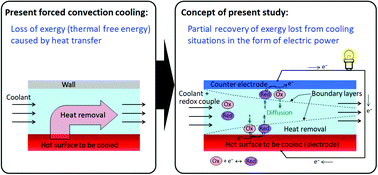Integration of thermo-electrochemical conversion into forced convection cooling†
Abstract
Forced convection cooling is important in numerous technologies ranging from microprocessors in data centers to turbines and engines, and active cooling is essential in these situations. However, active transfer of heat or thermal energy under a large temperature difference promptly destroys the exergy, which is the free-energy component of the thermal energy. In this study, to partially recover presently lost exergy in such situations, thermo-electrochemical conversion is integrated into forced convection cooling. We design and fabricate a test cell in which an electrolyte liquid is forced through a channel formed between two parallel electrodes and the hot-side electrode simulates an object to be cooled. Our experimental investigations show that the narrower interelectrode channels afford higher cooling and power generation performances. The mass transfer resistance is the most dominant type of resistance for all the conditions tested and the charge transfer kinetics is found to be controlled by the electrolyte viscosity. The dependence of the generated power on the flow rate is caused by the change in the diffusion coefficient of redox species with temperature. As an evaluation measure for such forced-flow thermo-electrochemical cells, the gain (Λ)—defined as the ratio of the generated power to the hydrodynamic pumping work required to force the liquid through the cell—is introduced. Λ is above unity in a certain flow rate region. This demonstrates that such a system can generate more electric power than the hydrodynamic pump work required to drive the liquid through the cell.



 Please wait while we load your content...
Please wait while we load your content...